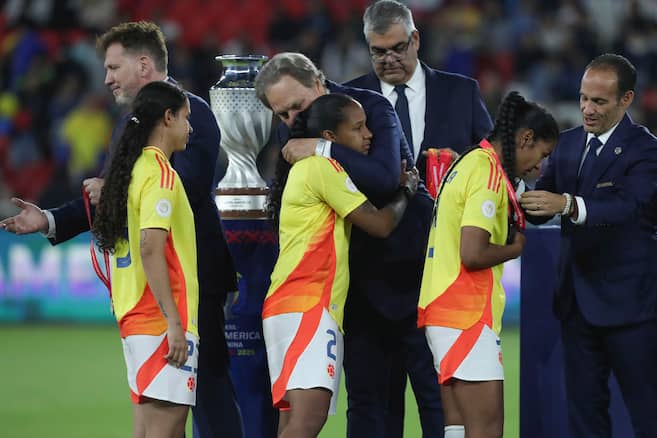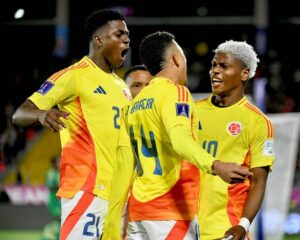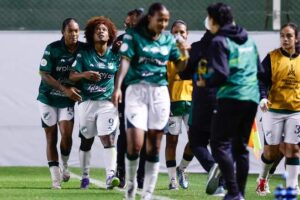

The players of the Colombian team receive the medals for their second place in the Copa América Women's, in Ecuador. EFE/ Jose Jáome
Photo: EFE – Jose Jácome
Summary and Fast Informame
Listen to this article
Audio generated with Google
“If we fall 10 times, 10 times we are going to get up. What a stone to have lost that way, but I have absolutely nothing to reproach this team,” Catalina Usme said on Saturday after the defeat of the Colombian National Team against that of Brazil in the final of the Copa América, in a dramatic definition of charges from the penalty point, after having tied 4-4 in the 120 minutes of play.
There was no revenge. Three years ago, in Bucaramanga, the tricolor also fell against Brazil, but in this tournament, based in Ecuador, it was clear that it is getting closer to glory. It was the best and most tight end of the history and footballically Colombia was at the height of the team that has won nine of the 10 editions that have been played.
But the road continues and the obstacles become motivations as has happened throughout the history of women's football in the country, which has been writing several decades, when the pioneers began to organize to play ball and dreamed that one day the achievements that the women's team has accumulated today would cease to be just a dream.
The Genesis of Women's Soccer in Colombia
Long before the explosion that women's football had in Colombia with the arrival of the new millennium, especially in the 2010 – with the first classifications to World Cups and the birth of the Professional League in 2017 -, the football played by women in the country began to take shape. For decades, players in different regions of the country made their way to an environment that turned their backs, organizing matches and tournaments in an artisanal way.
In Cali, in 1971, one of the first known female meetings was held, when two improvised teams represented Deportivo Cali and America in an exhibition match. This initiative promoted the creation of amateur championships that, between interruptions and obstacles, allowed a group of players to consolidate the first national tournament in 1991, taking a great step towards a federated structure.
Simultaneously, in Medellín, pioneers like Liliana Zapata began to mold women's football from the base, at a time when there were no official teams and much less institutional support. Zapata, who says that he started playing in the streets and neighborhood clubs, integrated the selection of Antioquia and witnessed how, little by little, the departmental leagues were organized to play the first National Interligas tournament. It was in that competition where about 18 departments, with teams formed from the collective effort, gave the initial kick to the official history of women's football in the country.
In Bogotá, Myriam Guerrero and Patricia Vanegas were the key figures of a movement that opened space in local universities and clubs. Guerrero, after training in Russia, founded the Vida Club and directed the National University team, while Vanegas found his way by reading a notice about a women's football tournament. That meeting was decisive: women from different departments agreed in Medellín in 1991 to play a championship that was more a tournament: it became an act of statement.
This consolidation process allowed Colombia to have a women's team in an international tournament, the South American Mar del Plata, Argentina in 1998. The base of that team emerged from the Interligas championships and clubs as intimate forms in Antioquia or International in Bogotá, founded by Vanegas.
It was a generation that, without professional league, without financial support and in the midst of precariousness, sowed the seeds of a historical change. These players formed the backbone of the selection that years later would begin to play World Cups, opening the way to an irruption that would change Colombian women's football in the 2010.
A revolutionary era
The regional tournaments that emerged in the 90s, driven by clubs created as intimate forms, palmiranos generations, life or international, were the silent quarry of a generation that appeared strongly in the 2010. The players who grew up in these processes, with little institutional support, were the ones that achieved the first great international jump of Colombian women's football.
The story would change since 2008, when the Sub 17 team achieved the title of the South American of Chile. It was the first winning team of Colombian women's football and the base of the squad that on June 28, 2011 debuted in the World Cup of Elders in Germany, marking a before and after for the discipline in the country.
That team arrived at the World Cup without a professional league, without rhythm of official competition and in the midst of difficulties. However, he brought with him the impulse of a young litter that also came to surprise the world a year earlier, when he reached the semifinals of the 2010 U-20 World Cup, when he ended in fourth place. That result was the warning that Colombia had talent, even if the road was uphill.
2010 was also the year of the first runner -up in the Women's Copa América, which granted the quota to the 2011 Absolute World Cup. That same generation, in 2009, he got gold in the Bolivarian Games (later he would repeat in 2013, 2017 and 2022). Without professional infrastructure, but with a group of players willing to break barriers, Colombia prepared for the biggest challenge in its history. In Germany, however, the draw was ruthless: Sweden, the United States and North Korea integrated the so -called “death group.” The Colombian failed to score goals and ended up eliminated in the group stage, but the impact of their presence on the World Cup was huge.
Before the cruel sentence of statistics, that participation could seem a failure. However, classifying a World Cup without a professional league, without official competition in the country and in front of selections with decades of advantage, was in itself an act of rebellion and determination. In addition, that squad was formed by names that would later be Colombian football badges: Sandra Sepúlveda, Natalia Gaitán, Lady Andrade, Yoreli Rincón, Catalina Usme and Daniela Montoya, among others.
The consolidation of this process would arrive four years later, in Canada 2015. Colombia repeated runner -up in the 2014 Copa América and obtained its ticket again to the orbital appointment. The team came more mature and with the experience of having broken the debut barrier. The story began to be written from the first game, when Daniela Montoya scored Colombia's first goal in a World Cup of seniors, with an unforgettable auction against Mexico, in a 1-1 draw that left a mark.
The coup of authority would arrive days later, when Colombia defeated France 2-0, then third in the FIFA Ranquin. Lady Andrade and Catalina Usme converted the goals of a historical victory that changed forever the perception of women's football in the country. The coffee makers advanced to the round of 16 as one of the best thirds, signing their best performance in a World Cup, despite falling into the third group of groups against England. The dream ran into the world power: United States. The American, who had already defeated Colombia in 2011, repeated the dose in eighths with goals from Megan Rapinoe and Carli Lloyd. However, the tour of the National Team in Canada was in memory as the deed that led to women's football to another level. It was the definitive proof that, despite the adversities, Colombia had a place to dream of the elite.
The impulse of Canada was key so that in 2017, after years of demands, Colombia took the step towards professionalization. The creation of the Women's Professional League was the logical consequence of years of struggle, although its development has been irregular and plagued by difficulties. Even so, the League served as a platform for exploits as the title of the Copa Libertadores achieved by Atlético Huila in 2018, and the international runners -up of America and Santa Fe in 2021. In 2019, in addition, the national team won the historic gold medal of the Pan American Games of Lima, a milestone.
The process opened the door to new generations. Players like Linda Caicedo and other promises of Colombian football began to forge their dreams with referents that had already broken barriers. The legacy of the pioneers, combined with the experience of soccer players like Usme and Montoya, became a selection that began to dream of larger peaks.
A consecration performance in Ecuador 2025
The subtitle of the Colombian National Team in the Copa América 2025 is not one more. The team demonstrated hierarchy and as never before, Brazil faced you. In fact, it was better in the final, beyond which the Verdeamarillas took the caste and balanced the score at the end of desire and thrust.
That is not a consequence of luck, but the result of a history of resistance, of matches played in anonymity, of teams formed without resources, and of women who, by force of talent and conviction, demolished barriers until Colombia was code with the elite of the continent.
For several years the national team competes to Brazil, the historical power of South America, but this time it really suffered it, it made it look bad. In 2022, Colombia planted face, but was not excited at any time with the title, to the point that was satisfied with the classification to the World Cup of the following year, when it fell with England – today European two -time champion – by the minimum difference in the quarterfinals, and the Olympic Games of Paris 2024, when it lost in the same instance against Spain, the world champion.
Now the feeling is different, because Colombia was better on the court, which generates satisfaction and bitterness. There was how to overcome the milestone that conducted the foundations of Colombian football: the runner-up of the U-17 team in the World Cup in India in 2022. That generation, led by a brilliant cute Caicedo, achieved the best result in the history of Colombia in any FIFA tournament, adding men and women. And they got everything in the midst of structural deficiencies. Although support has multiplied a lot in recent years, the absence of a stable professional league, the lack of investment and constant organizational crises still prevails.
The professionalization, which began in 2017, was an yearning for the pioneers who saw the dream materialize with 18 clubs in competition. However, in the midst of glory contexts, there were also setbacks. Between 2019 and 2021, the League suffered cancellations, allegations of harassment and precarious working conditions. Only five teams formalized contracts in 2021. Despite organizing in 2022 a special tournament with 150 matches and breaking attendance records, the Dimayor canceled the second semester championship, leaving the institutional fragility of women's football in Colombia in Colombia. Today, in 2025, the Women's League only has one tournament, guaranteeing just five months of competition for the country's players. The selection continues to break international barriers, while at the local level the fight continues.
The Copa América title remains a pending account, an objective that we know can be conquered. The fight to achieve this will continue. Women who defend women's football in Colombia will continue, with their hearts, with rebellion and with the conviction intact that the girls in the country, the future of sport, can continue playing ball.
🚴🏻⚽🏀 The latest in sports?: Everything you should know about world sport is in the spectator

